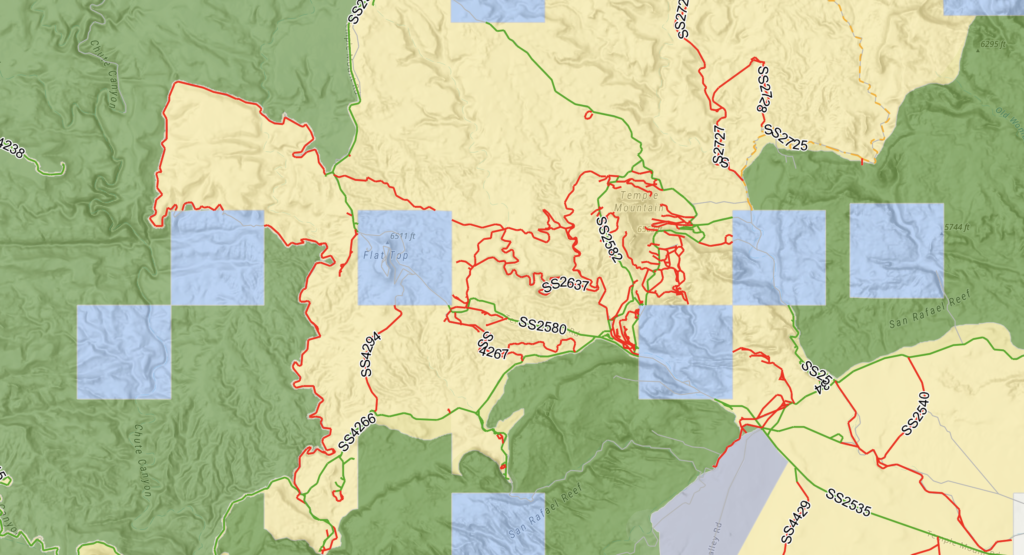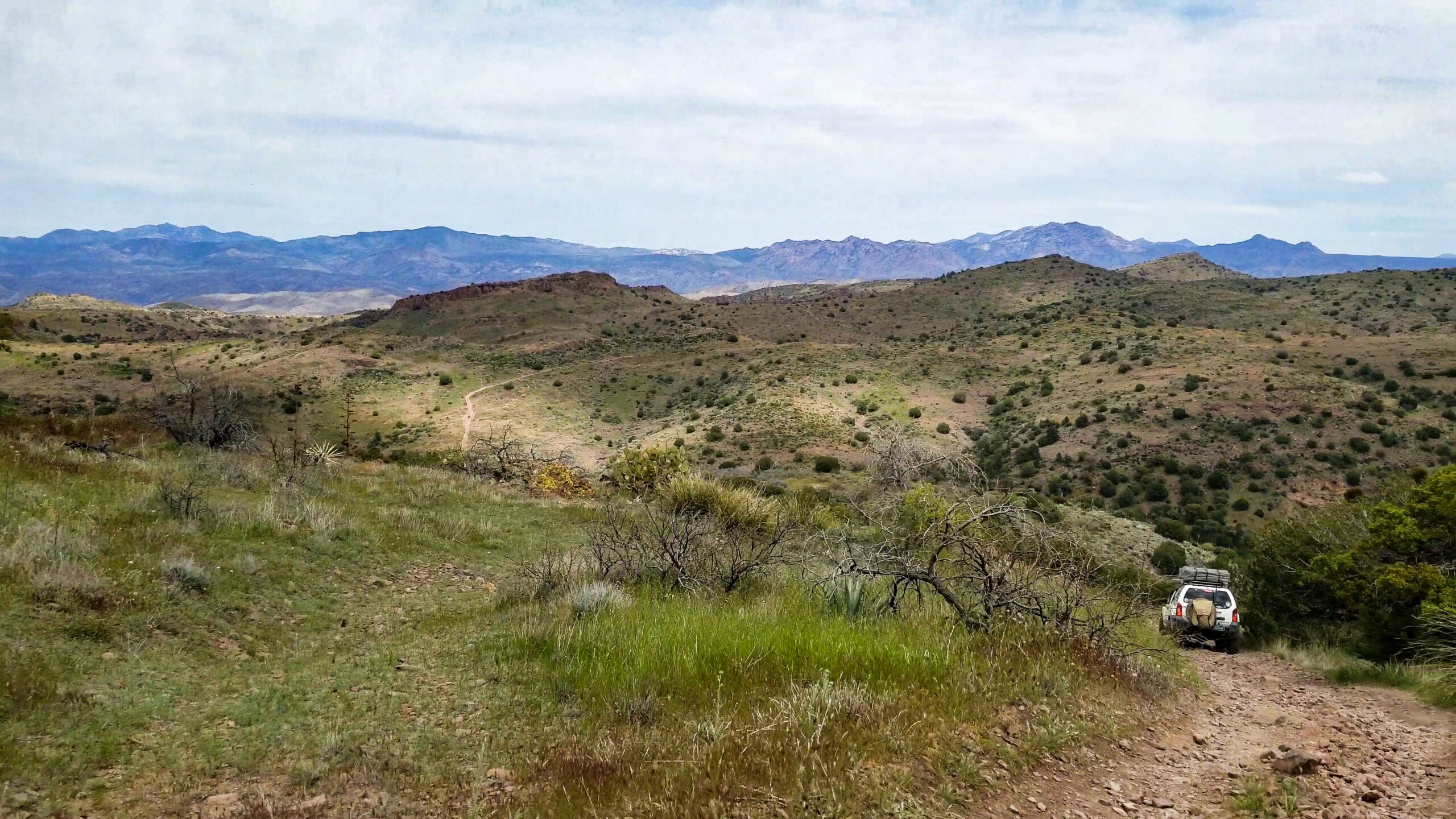Your cart is currently empty!
Posted in
Earlier this week, anti-access wilderness groups celebrated the five year anniversary of the passage of the Dingell Act. This law was passed by Congress and signed into law on March 12, 2019. In Utah this law is often referred to as the the Emery County Wilderness Bill that designated 663,000 acres of Wilderness in Utah in the area of the San Rafael Swell and along the Green River.
BlueRibbon Coalition has been actively participating in the implementation of this act since it was passed, and the motorized recreation community was heavily involved in trying to prevent the law from being passed because of the serious restrictions on access that would come from the designation of 663,000 acres of Wilderness.
With the release of the proposed travel management alternatives for the San Rafael Swell, we are not surprised to see that the Bureau of Land Management is proposing substantial restrictions on public access to this area on top of the nearly 700,000 acres of wilderness that was already created. Many of us were worried that the Dingell Act was filled with empty promises and hollow, unenforceable protections, and now we are learning that those who negotiated the Dingell Act have a lot of explaining to do.
Here are seven lessons we’ve learned from the failure of the Emery County portion of the Dingell Act to live up to its promises of protecting public lands for public access.
Buffer Zone Prohibitions Don’t Appear to Mean Anything. The Dingell Act expressly prohibited the creation of buffer zones around the 660,000 acres of wilderness. This is Congress’s way of defining “balanced management” through statute. The areas that are designated as Wilderness are managed with rigid restrictions, and as such these wilderness areas are set aside to ensure that wildlife, vegetation, dark skies, soils, watersheds, habitats, viewheds, soundscapes, and solitude are protected in the wilderness areas. The areas not designated as wilderness are supposed to prioritize multiple-use, which includes motorized recreation. To prevent what we call “wilderness laundering,” Congress includes language in wilderness designations to prevent management decisions that would create new de-facto wilderness around the wilderness called buffer zones. A simple glance at the proposed road closures in the San Rafael Swell travel plan shows that the BLM has no functional, operative framework for following Congress’s clearly worded prohibition against the creation of buffer zones. The BLM is proposing to close hundreds of miles of routes in the near vicinity of wilderness areas, and if they choose the most restrictive alternative they will be blatantly violating the Dingell Act while created tens of thousands of acres of de facto wilderness. They justify the proposed closure of these routes by their need to protect resources that are already being adequately protected by the 660,000 acres of wilderness in this area. The best way for Congress to prevent BLM from misreading or ignoring its blatantly articulated statutory mandates is to stop creating new wilderness areas. Wilderness advocates cannot be trusted in these negotiations to uphold their end of the bargains that are reached, and there are too many administrative tools at their disposal that can be used to create de facto wilderness protections on our multiple use lands.
Cherry stemmed roads are a tool to create wilderness. They are not a tool for protecting routes. Wilderness is defined in the law as 5,000 contiguous acres of land that contains no roads. There are so many roads in the San Rafael Swell, that little – if any – of the lands in the Swell should have been eligible for wilderness protection. In order to designate wilderness in this area, roads had to be decommissioned and several roads were excluded from the wilderness areas through a cartographic trick called “cherry-stemming.” A cherry-stemmed route technically isn’t included as part of the wilderness area, and as long as the route doesn’t completely transect the 5,000 contiguous acres of land, that land can be considered wilderness – even though it has a road running right through it. Devils Racetrack, Behind the Reef, Swasey’s Leap, Eagle Canyon, Reds Canyon, and numerous other routes were designated as cherry-stemmed roads in the San Rafael Swell. The good news is that these roads will never be closed unless the Dingell Act is repealed. The bad news is that the existence of these routes should have prevented the wilderness designation in the first place. Congress should never designate another acre of wilderness that requires cherry-stemming of roads. If Congress makes wilderness designations, they should always codify all remaining roads outside of the wilderness to be designated as open.
map shows route being cherry-stemmed through shaded wilderness
Historical Cold War site protections are being ignored . The Dingell Act contains novel language the BLM needs to manage historical Cold War sites and uranium mines for public education purposes. The San Rafael Travel Plan proposes to restrict access to dozens of these sites. It’s difficult to go learn about the many cool old uranium mines in the San Rafael Swell if access to the sites is closed. While the language in the Dingell Act is clear, it apparently wasn’t clear enough to prevent the BLM from proposing to close these sites and the routes that lead to them.
Mining Site that is proposed for closure
It was unbalanced to create 663,000 acres designated Wilderness and only 217,000 acres of special recreation management area (SRMA). When the BLM released its preliminary travel plan alternatives, wilderness advocates started repeating their tired narrative that the BLM needs to “bring balance to the management of the area” by closing hundreds of miles of roads. Even with 3 acres of aggressively protected wilderness for every acre of recreation priority land in the San Rafael Swell, they are still saying this is “unbalanced.” Because the wilderness groups are abandoning the compromise that made the Dingell Act possible, Congress should answer their call to restore balance to this area and remove wilderness protections from 223,000 acres in this area in order to restore balance and get a 50/50 ratio. It will never be balanced by environmentalists standards. Quit letting them be the judge and restore actual balance to the management of this area using the simple math of 1 acre of wilderness for 1 acre of multiple use.
The Dingell Act should have Cherry-stemmed or designated as open every inch of RS2477 routes and all routes that access State Trust Lands. The Historic Roadways Protection Act, would prevent the BLM from closing these routes and correct this glaring error in the Dingell Act.
Wild and Scenic River Designations were a failure. The Dingell Act designated 5.3 miles of the Green River as Wild, which means the BLM must manage this mileage with restrictions similar to a wilderness area. The Act designated 8.5 miles as a Recreation Segment, with means the BLM needs to manage this mileage for recreation access to the river. The Act also designated 49.2 miles as Scenic, which prevents major industrialization or development but still allows access for recreation and primitive roads. The Labyrinth Rims plan in Moab created a de facto “Wild” designation for a substantial portion of the 49.2 miles that were designated as Scenic by closing routes that offered scenic overlooks, and access by primitive routes to the river.
Popular scenic viewpoint and campsite closed by BLM contrary to “Scenic” River Segment Designation
Dingell Act management does bleed over to other counties. This action by Congress was intended to just affect Emery County, Utah and small portions of Uintah County. It has affected many other surrounding counties. Doing a county by county bill simply does not work. Congress shouldn’t do county specific public land bills moving forward. Because of abuse of administrative discretion and litigation pressure from wilderness advocates, there is no way to contain the impacts of a county-specific public land bill to a single county.
These seven lessons have resulted in the need to engage in expensive and costly litigation for the State of Utah and groups like BlueRibbon Coalition. We expected these failures, which is why we opposed this legislation. This is also why we oppose new wilderness proposals. Before the ink even dries on a new wilderness designation, wilderness advocates come back to the table with complaints that management is unbalanced and resources aren’t protected. It’s unfortunate that leaders in Emery County and the State of Utah fell for the San Rafael Swindle.
Tags:
You may also like…

Visit the AZBackroads.com Store

Please Become A Member
We need your help to keep our backroads open. Please join today!








